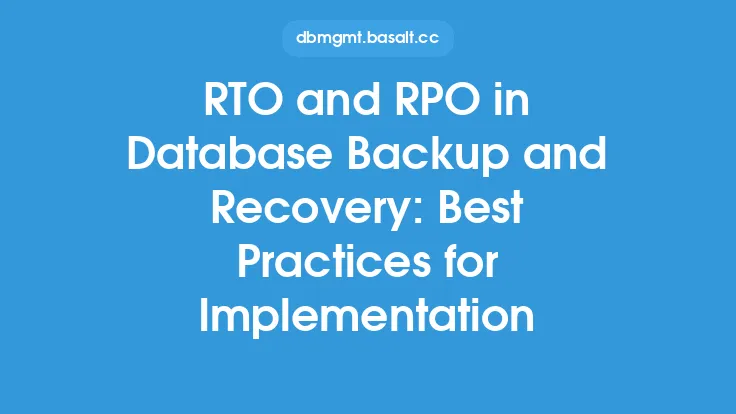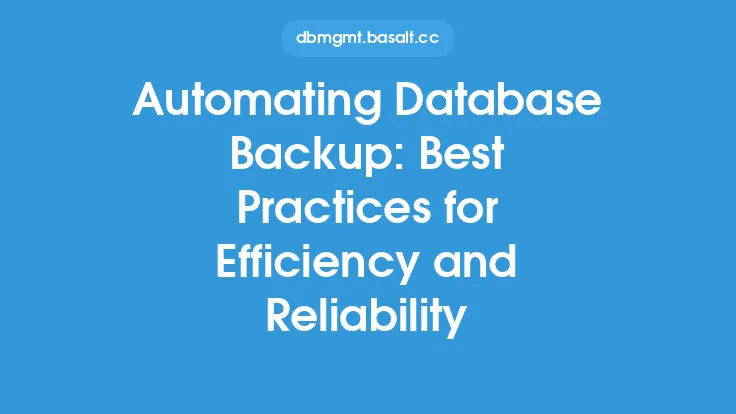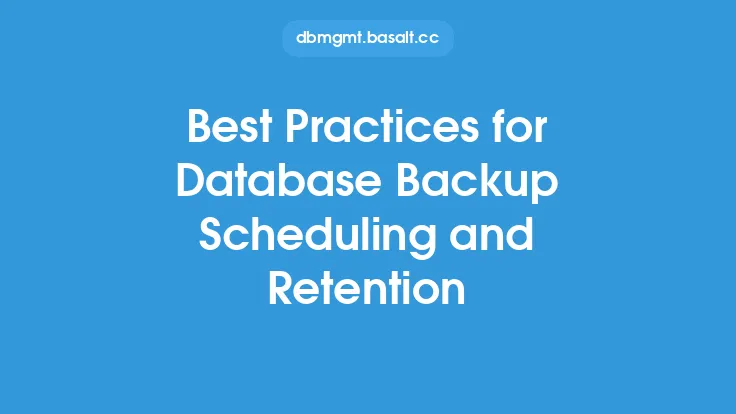Database backup and recovery are crucial aspects of database maintenance, ensuring that data is protected and can be restored in case of failures, errors, or disasters. A well-planned backup and recovery strategy is essential for minimizing data loss and downtime, thereby maintaining business continuity. In this article, we will delve into the best practices for database backup and recovery, providing a comprehensive guide for database administrators and professionals.
Introduction to Database Backup
Database backup is the process of creating copies of database files, which can be used to restore the database in case of data loss or corruption. There are several types of database backups, including full backups, incremental backups, differential backups, and transaction log backups. Full backups involve copying all database files, while incremental backups capture changes made since the last full backup. Differential backups, on the other hand, contain all changes made since the last full backup, and transaction log backups record all transactions performed on the database.
Database Backup Strategies
A good database backup strategy should consider several factors, including the type of data, database size, and recovery time objectives (RTOs). The 3-2-1 rule is a widely accepted best practice, which states that at least three copies of data should be maintained, on two different types of media, with one copy stored offsite. This ensures that data is protected against hardware failures, software corruption, and site disasters. Additionally, backups should be performed regularly, with the frequency depending on the database's activity level and data criticality.
Database Backup Tools and Techniques
There are various database backup tools and techniques available, including native database tools, third-party software, and cloud-based services. Native database tools, such as SQL Server's backup utility, provide a basic level of backup functionality. Third-party software, like Veritas NetBackup and Commvault, offer more advanced features, including automation, compression, and encryption. Cloud-based services, such as Amazon S3 and Microsoft Azure Blob Storage, provide a scalable and secure way to store backups. When choosing a backup tool, consider factors like compatibility, performance, and cost.
Database Recovery Techniques
Database recovery involves restoring the database from backup files, which can be a complex and time-consuming process. There are several database recovery techniques, including restore from backup, point-in-time recovery, and database replication. Restore from backup involves restoring the entire database from a backup file, while point-in-time recovery allows for recovery to a specific point in time. Database replication involves maintaining a duplicate copy of the database, which can be used for recovery in case of a failure.
Best Practices for Database Backup and Recovery
To ensure effective database backup and recovery, follow these best practices:
- Develop a comprehensive backup strategy that considers data criticality, RTOs, and recovery point objectives (RPOs).
- Use a combination of backup types, including full, incremental, and differential backups.
- Store backups on multiple media types, including disk, tape, and cloud storage.
- Test backups regularly to ensure data integrity and recoverability.
- Use automation tools to streamline backup and recovery processes.
- Monitor backup and recovery jobs to detect errors and exceptions.
- Document backup and recovery procedures to ensure knowledge sharing and continuity.
Common Challenges in Database Backup and Recovery
Despite the importance of database backup and recovery, several challenges can arise, including data growth, backup window constraints, and recovery time objectives. Data growth can lead to increased backup times and storage requirements, while backup window constraints can limit the frequency and duration of backups. Recovery time objectives can be challenging to meet, especially in cases where large amounts of data need to be recovered. To overcome these challenges, consider using data deduplication, compression, and parallel processing techniques to optimize backup and recovery performance.
Future of Database Backup and Recovery
The future of database backup and recovery is likely to be shaped by emerging technologies, including cloud computing, artificial intelligence, and machine learning. Cloud-based backup and recovery services will continue to grow in popularity, offering scalable and secure storage options. Artificial intelligence and machine learning will be used to optimize backup and recovery processes, predict data growth, and detect potential errors. Additionally, the increasing use of containerization and virtualization will require new backup and recovery strategies, which can handle the dynamic nature of these environments.
Conclusion
In conclusion, database backup and recovery are critical components of database maintenance, ensuring that data is protected and can be restored in case of failures, errors, or disasters. By following best practices, using the right tools and techniques, and overcoming common challenges, database administrators can develop effective backup and recovery strategies that meet their organization's needs. As technology continues to evolve, it is essential to stay informed about emerging trends and technologies, which can help improve database backup and recovery processes, ensuring business continuity and data integrity.





